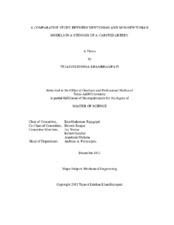| dc.contributor.advisor | Kumbhakonam, Rajagopal | |
| dc.contributor.advisor | Ranjan, Devesh | |
| dc.creator | Khambhampati, Tejasvi Krishna | |
| dc.date.accessioned | 2014-05-13T17:29:29Z | |
| dc.date.available | 2015-12-01T06:31:10Z | |
| dc.date.created | 2013-12 | |
| dc.date.issued | 2013-12-10 | |
| dc.date.submitted | December 2013 | |
| dc.identifier.uri | https://hdl.handle.net/1969.1/151909 | |
| dc.description.abstract | Blood, the most significant biological fluids plays a very vital role in the human mechanism, in terms of supplying the required nutrients to different parts of the human body, removing waste products and defending the body against infection through the action of antibodies. Therefore, it is imperative that blood flow must be studied in great detail. Hemodynamic analysis of blood flow in vascular beds and prosthetic devices requires the rheological behavior of blood to be characterized through appropriate constitutive equations relating the stress to deformation and rate of deformation. Numerical simulations, although not very accurate, provide an excellent alternative around this difficulty.
As part of the preliminary studies, the Newtonian model of blood was assumed, and wall shear stresses have been plotted at certain critical points. Profiles of wall shear stress were then compared with the experimental results of Ku and Giddens. A numerical investigation of blood flow in stenosed carotid artery of the human body is presented in this thesis. Using a three-dimensional computational model of the stenosis, simulations were performed to capture the Non-Newtonian behavior of blood. The flow is considered as being pulsatile, with appropriate realistic boundary conditions.
A shear thinning model (Carreau’s) and a visco-elastic model (Yeleswarapu’s Olydroyd-B model) have been employed to predict wall shear stress for the case of a healthy carotid artery and two cases of stenosed carotid artery models (50% and 90% stenosed carotid artery). From these simulation results, it was observed that wall shear stresses predicted by the models at certain critical points are different. Recirculation zones, flow separation and associated negative wall shear stress were observed in certain cases. | en |
| dc.format.mimetype | application/pdf | |
| dc.language.iso | en | |
| dc.subject | Non-Newtonian | en |
| dc.subject | pulsatile | en |
| dc.subject | blood flow | en |
| dc.subject | simulations | en |
| dc.subject | stenoses | en |
| dc.subject | carotid artery bifurcation | en |
| dc.subject | shear thinning models | en |
| dc.subject | viscoelastic models | en |
| dc.title | A Comparative Study between Newtonian and Non-Newtonian Models in a Stenosis of a Carotid Artery | en |
| dc.type | Thesis | en |
| thesis.degree.department | Mechanical Engineering | en |
| thesis.degree.discipline | Mechanical Engineering | en |
| thesis.degree.grantor | Texas A & M University | en |
| thesis.degree.name | Master of Science | en |
| thesis.degree.level | Masters | en |
| dc.contributor.committeeMember | Handler, Robert | |
| dc.contributor.committeeMember | Walton, Jay | |
| dc.contributor.committeeMember | Anastasia, Muliana | |
| dc.type.material | text | en |
| dc.date.updated | 2014-05-13T17:29:29Z | |
| local.embargo.terms | 2015-12-01 | |


